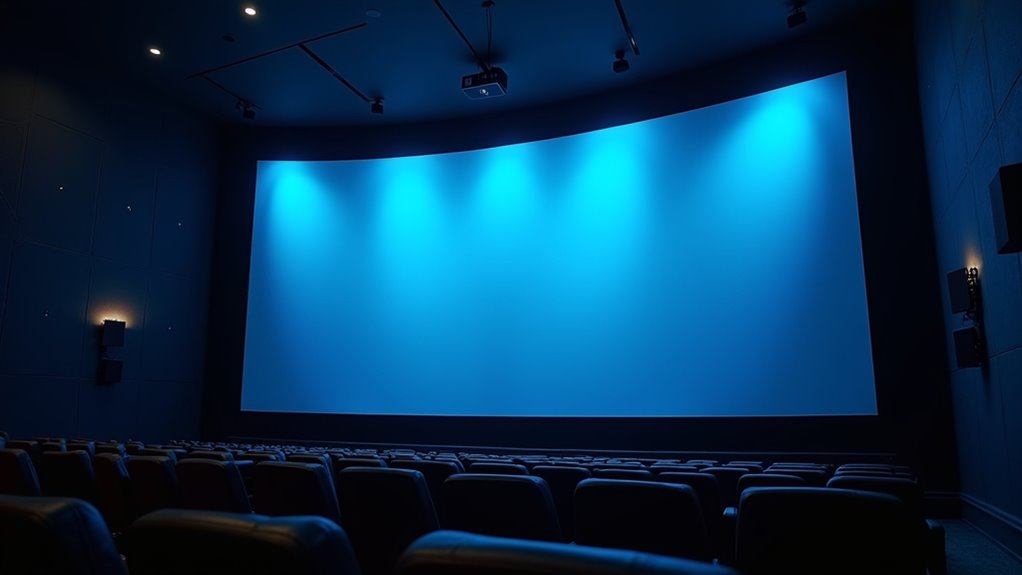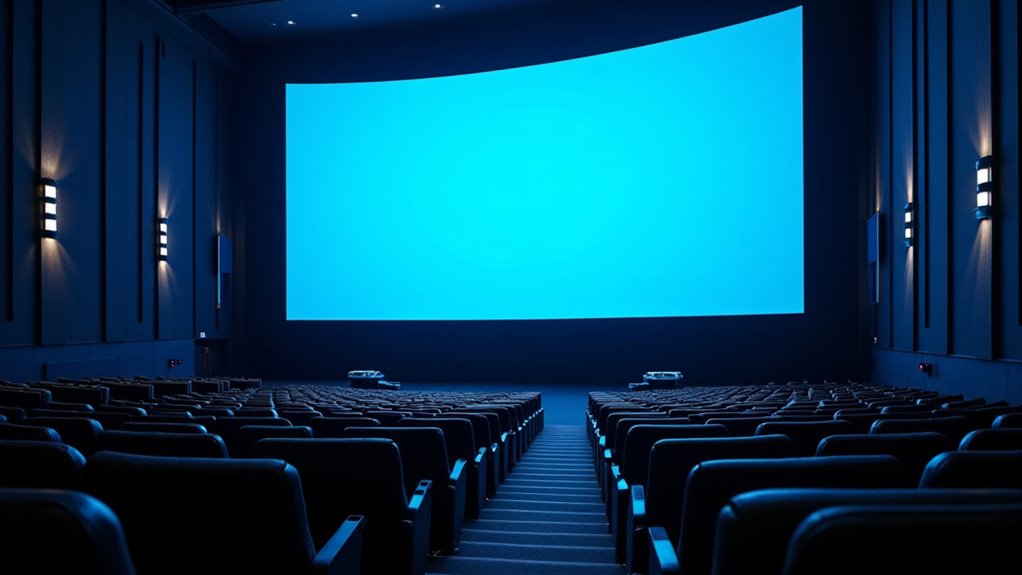IMAX stands apart through its revolutionary combination of massive screens reaching nearly 40 meters, state-of-the-art laser projection systems, and immersive sound technology that puts viewers in the middle of the action. Since its 1967 debut, IMAX has evolved from educational venues to mainstream entertainment, utilizing proprietary cameras and digital remastering to deliver crystal-clear images with unmatched clarity. Its unique aspect ratios and stadium seating transform ordinary films into larger-than-life experiences, making standard theaters feel rather quaint in comparison.
The Revolutionary Technology Behind IMAX’s Crystal-Clear Experience

Every aspect of IMAX’s groundbreaking technology works in perfect harmony to deliver what many consider the gold standard of cinematic experiences.
From its state-of-the-art laser projection systems to its customized optical engines, IMAX pushes the boundaries of what’s possible in modern cinema. The proprietary Rolling Loop technology ensures each frame sits perfectly still during projection, while cutting-edge 4K laser systems beam incredibly bright, razor-sharp images onto massive screens. With screens reaching up to eight stories high, IMAX creates an unparalleled sense of scale that truly engulfs viewers in the action. Multi-channel sound systems positioned strategically behind the screen and throughout the theater create an enveloping audio experience.
IMAX’s revolutionary projection technology delivers unparalleled image quality, combining precision mechanics with advanced laser systems for breathtaking cinematic clarity.
The technical wizardry extends beyond just pretty pictures, though. IMAX’s sound system packs enough bass to shake your popcorn while maintaining crystal-clear dialogue that won’t get lost in the mix.
The specialized cameras, with their larger-than-life film frames and dual-lens 3D capabilities, capture every detail with stunning clarity. When combined with higher frame rates of up to 60fps, the result is a viewing experience so smooth and immersive, it’s like having a front-row seat to reality itself.
From Science Centers to Hollywood: IMAX’s Incredible Journey
Since its humble beginnings in 1967, IMAX’s path from educational venues to Hollywood blockbusters reads like a classic tale of innovation meets opportunity.
Originally founded as Multiscreen Corporation, the company first found its footing in science centers and museums, where the massive screens brought educational content to life in unprecedented ways. The company’s advanced projection systems consistently delivered unmatched visual quality.
The turning point came when institutions like the Reuben H. Fleet Science Center and Detroit Science Center adopted IMAX technology, proving that audiences craved larger-than-life viewing experiences. The Detroit Science Center’s installation became the third dome theater worldwide when it opened in 1978.
This educational phase served as a crucial testing ground, allowing IMAX to perfect its technology while building a loyal following.
As the format matured, Hollywood took notice, and films like “To Fly” at the National Air and Space Museum demonstrated IMAX’s potential for mainstream entertainment.
Today, with over 1,500 theaters worldwide, IMAX has evolved from a science center novelty into an entertainment powerhouse, transforming how audiences experience cinema while maintaining its commitment to technological innovation.
Why IMAX Delivers the Ultimate Movie-Going Experience

What makes IMAX the gold standard of cinema experiences lies in its revolutionary combination of cutting-edge technology and immersive design elements.
With screens towering up to 38.8 meters high and utilizing unique aspect ratios of 1.43:1 or 1.90:1, IMAX delivers up to 40% more visual information than standard formats, transforming even the most basic action sequence into a jaw-dropping spectacle.
The magic doesn’t stop at visuals, though. IMAX’s dual digital projection system works in perfect harmony with its precision-tuned sound technology, creating an audiovisual symphony that puts viewers right in the middle of the action. Films like Avatar 2 maximize this experience through IMAX certified cameras to deliver unprecedented visual quality.
The carefully engineered theater design, featuring steep stadium seating and optimal screen placement, ensures that whether you’re watching the latest superhero blockbuster or a nature documentary, every seat becomes the best seat in the house.
Despite premium pricing, audiences continue flocking to IMAX theaters, proving that when it comes to cinematic immersion, bigger really is better. The system’s innovative Digital Re-mastering process enhances everything from color saturation to sound quality, ensuring each film reaches its maximum potential.
Frequently Asked Questions
How Much More Expensive Is an IMAX Ticket Compared to Regular Cinema?
IMAX tickets typically cost 30-50% more than standard movie tickets, with prices varying significantly by location and format.
In major cities, while regular tickets average $12-15, IMAX screenings can command $18-25 for 2D and $21-30 for 3D shows.
Premium IMAX experiences in prime locations, especially for blockbuster releases, can push prices even higher, sometimes reaching double the standard ticket cost.
Can Watching IMAX Movies Cause Motion Sickness or Eye Strain?
IMAX movies can indeed trigger motion sickness and eye strain in some viewers.
The massive screen size, high-resolution visuals, and immersive sound create a sensory-rich environment that may cause visual-vestibular conflict, where the brain struggles to reconcile stationary body positioning with intense on-screen motion.
Viewers can minimize these effects by sitting farther back, taking visual breaks, and avoiding films with intense motion sequences if particularly susceptible.
Which Seats Provide the Best Viewing Experience in an IMAX Theater?
The optimal IMAX viewing experience comes from seats located in the center section, roughly two-thirds back from the screen, just above the theater’s midline.
This “sweet spot” provides perfect screen symmetry, balanced sound distribution, and comfortable viewing angles without neck strain.
While IMAX’s stadium-style seating ensures decent sightlines throughout, the middle seats in rows G-K typically offer the most immersive and ergonomic experience.
Are All IMAX Theaters the Same Size and Quality Worldwide?
IMAX theaters vary significantly in size and specifications worldwide, though quality standards remain consistent through strict corporate oversight.
While the average screen measures 22m x 16m, some installations, like Germany’s Leonberg IMAX, boast massive 125 ft x 72 ft screens.
Despite physical differences between classic IMAX venues and multiplex locations, the company maintains uniform audio-visual excellence through standardized technology, proprietary algorithms, and rigorous quality control measures.
How Can I Tell if a Movie Was Actually Filmed in IMAX?
Viewers can identify true IMAX footage by looking for sudden aspect ratio changes during a film, where the image expands to fill the entire screen.
Additionally, IMAX scenes display noticeably higher clarity, detail, and color depth compared to standard footage.
Movies’ end credits typically list “Filmed in IMAX” if genuine IMAX cameras were used, while marketing materials and official websites often specify which sequences were shot in the format.
